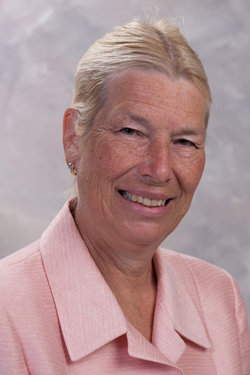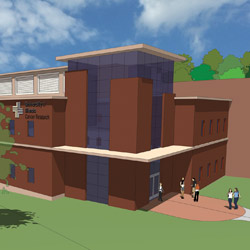
This summer, we will break ground on the new Cancer Research Facility. This expansion will ultimately add about 20,000 square feet of research laboratory space. Why is the development of this facility so important?
Most importantly, we believe we can contribute to finding a cure for cancer. The research that Dr. Jasti Rao and his team are performing is remarkable. When we take people on a tour of our existing laboratory, they are always astounded. Imagine what we can accomplish with more space! Although this research is very technical and complicated, let me try to explain a few of the recent projects.
Like all other tissues, cancers need to have blood vessels bringing them blood, nutrients and oxygen if they are to grow. Cancers release certain substances that signal the blood vessels to increase in size and number so that they can feed the cancer. Our experiments identify ways to prevent this from occurring. Then, without blood vessels to feed them, the cancer cannot grow and will sometimes die.
Cancers also release proteases, which are small molecules (enzymes). Proteases digest the normal tissue around a cancer. Once the normal tissue is digested, the cancer can grow and fill that space, where it releases more proteases in order to grow yet again. Our studies find ways to block proteases so the tumor cannot expand in size.
A third example is our work in stem cells obtained from donated umbilical cord blood. We have found that injected umbilical cord stem cells will sometimes migrate to the site of a cancer where they attack and kill the cancer cells.
 This research requires some fascinating—and expensive—technology. My favorite technique is one in which researchers take the firefly luminescence gene (the one responsible for making fireflies glow at night) and put it in a cancer cell. Then the cancer cells glow, so we can see if and how much they have grown.
This research requires some fascinating—and expensive—technology. My favorite technique is one in which researchers take the firefly luminescence gene (the one responsible for making fireflies glow at night) and put it in a cancer cell. Then the cancer cells glow, so we can see if and how much they have grown.
Since Dr. Rao’s arrival in 2001, the Cancer Biology program has published 104 research papers in respected science journals. The work performed by Dr. Rao and his research team occurs in the laboratory, but we expect that some of it will soon be tested in humans. Dr. Rao has received a patent for one of the discoveries made in our UICOMP research laboratory. Our new facility will allow us to recruit additional talented researchers and will facilitate our current research, hopefully leading to discoveries important to finding a cure for cancer.
This Cancer Research Facility expansion will also bring important direct fiscal benefits to Peoria. The current Cancer Biology Research Program brought in $3.1 million in grant funding during the last fiscal year. Since the program began with the recruitment of Dr. Jasti Rao, the program has been awarded a total of $27.1 million in grant funding. (Dr. Rao’s grant awards alone total $22.4 million.) Most of this money remains within our community. Further expansion of the research program requires more space and the recruitment of additional researchers. The new Cancer Research Facility will result in additional skilled jobs, drawing even more talented people to our community.
The presence of research laboratory space assists the community in other ways. It is imperative that Peoria continue to recruit highly skilled and sub-specialized physicians if it is to continue to provide patients with complete and technologically advanced medical care. Some of these physicians will only come to a community that offers them research opportunities. The growth of research laboratory space allows Peoria to recruit the best and brightest of physicians. In fact, the presence of research space was key to the recent recruitment of a neurosurgeon specializing in brain tumors and a pediatric specialist in neurologic disorders.
Dr. Don Rager, previous dean of the medical school, began the dream of an expanded Cancer Research Facility, and Dr. Rod Lorenz worked to further this dream. I’m immensely thankful to them, Dr. Rao, and all of our community donors and partners for their hard work. I’m pleased and excited that this summer we will actually begin construction, and I look forward to seeing this community reap the rewards of our expanded cancer research facility. iBi

